Intel Xeon E-2288G Benchmarks
For this exercise, we are using our legacy Linux-Bench scripts which help us see cross-platform “least common denominator” results we have been using for years as well as several results from our updated Linux-Bench2 scripts. At this point, our benchmarking sessions take days to run and we are generating well over a thousand data points. We are also running workloads for software companies that want to see how their software works on the latest hardware. As a result, this is a small sample of the data we are collecting and can share publicly. Our position is always that we are happy to provide some free data but we also have services to let companies run their own workloads in our lab, such as with our DemoEval service. What we do provide is an extremely controlled environment where we know every step is exactly the same and each run is done in a real-world data center, not a test bench.
We are going to show off a few results, and highlight a number of interesting data points in this article.
Python Linux 4.4.2 Kernel Compile Benchmark
This is one of the most requested benchmarks for STH over the past few years. The task was simple, we have a standard configuration file, the Linux 4.4.2 kernel from kernel.org, and make the standard auto-generated configuration utilizing every thread in the system. We are expressing results in terms of compiles per hour to make the results easier to read:
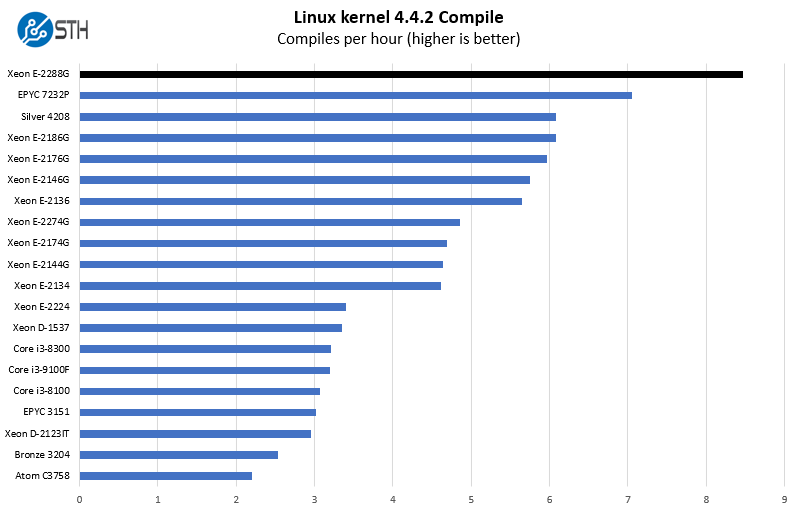
Clock speed matters. The AMD EPYC 7232P and Intel Xeon Silver 4208 have higher memory bandwidth with more memory channels and higher memory clock speed. They are both eight cores like the Xeon E-2288G. Yet we see the high clock speeds of the Xeon E-2288G prevail here.
c-ray 1.1 Performance
We have been using c-ray for our performance testing for years now. It is a ray tracing benchmark that is extremely popular to show differences in processors under multi-threaded workloads. We are going to use our 8K results which work well at this end of the performance spectrum.
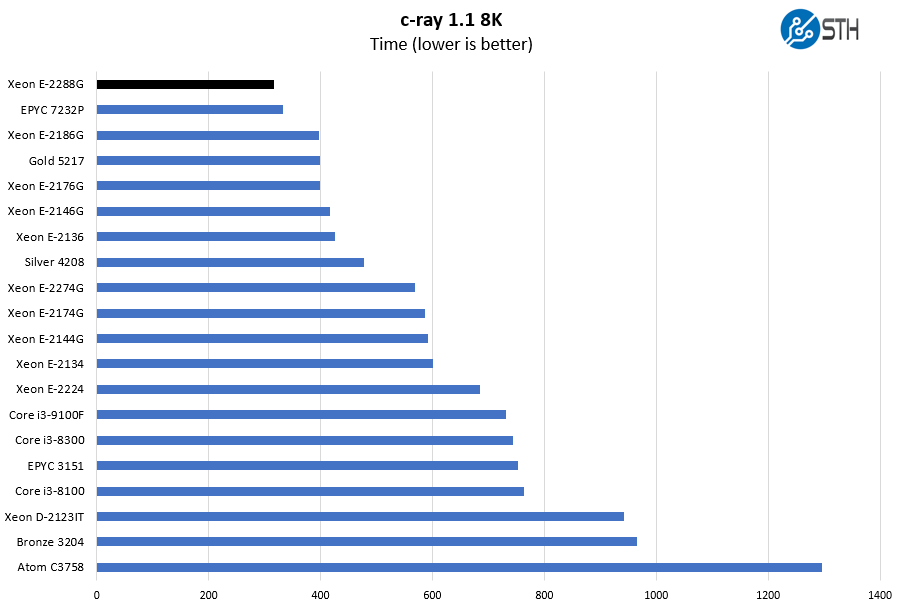
The performance goes beyond the Intel Xeon Silver line as well. We also pulled in 8-core Intel Xeon Gold 5217 results to show what an 8-core “optimized” Xeon Scalable does in comparison, and the clock speed of the E-2288G is simply on another level.
7-zip Compression Performance
7-zip is a widely used compression/ decompression program that works cross-platform. We started using the program during our early days with Windows testing. It is now part of Linux-Bench.
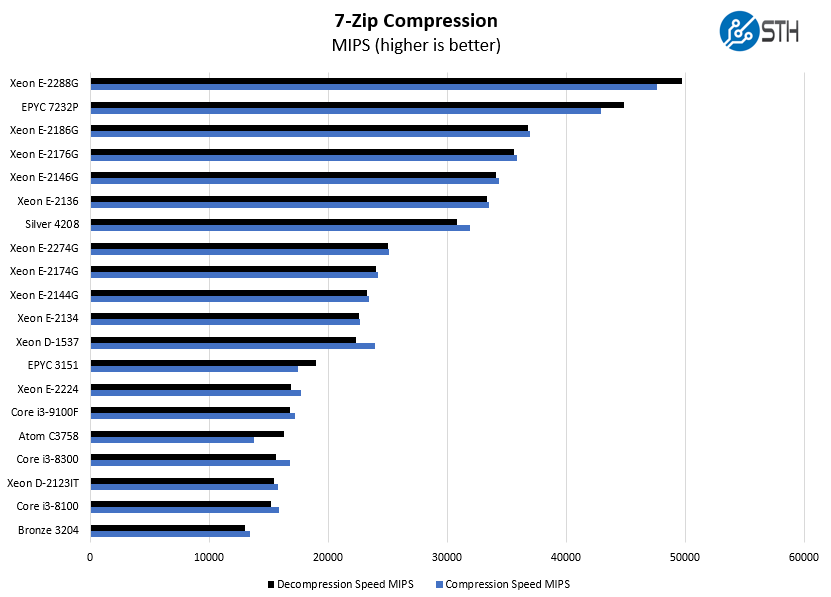
In our charts, we are also including a dozen of other socket LGA1151 alternatives from the current and previous generations. That includes the Intel Core i3-9100F at the current-generation lower-end and chips like the Xeon E-2224 and Xeon E-2274G from this generation.
NAMD Performance
NAMD is a molecular modeling benchmark developed by the Theoretical and Computational Biophysics Group in the Beckman Institute for Advanced Science and Technology at the University of Illinois at Urbana-Champaign. More information on the benchmark can be found here. We are going to augment this with GROMACS in the next-generation Linux-Bench in the near future. With GROMACS we have been working hard to support Intel’s Skylake AVX-512 and AVX2 supporting AMD Zen architecture. Here are the comparison results for the legacy data set:
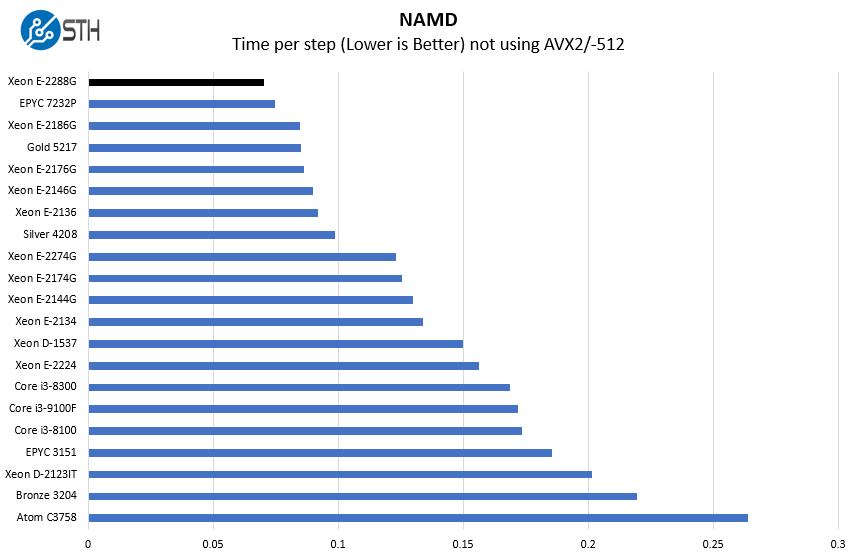
At the edge, where the Intel Xeon E-2288G may be deployed, we sometimes see embedded CPUs. We added the Xeon D-2123IT and Xeon D-1537 in these results to put some sense of relative performance on the Xeon D lines. We also have the Intel Atom C3758 8-core results in here to give you some sense of relative performance.
Sysbench CPU test
Sysbench is another one of those widely used Linux benchmarks. We specifically are using the CPU test, not the OLTP test that we use for some storage testing.
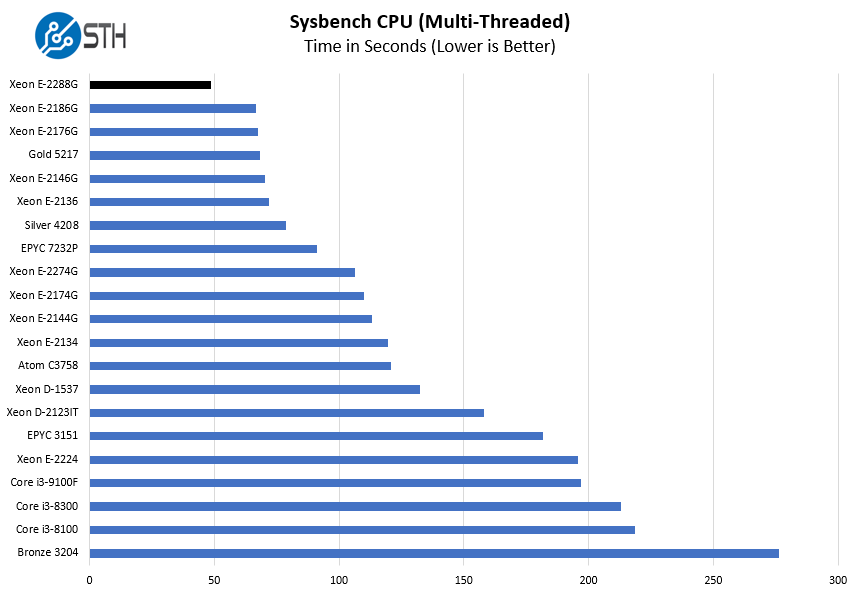
One result that stands out across these results is performance versus the Intel Xeon E-2224 which is a four-core chip without Hyper-Threading. Between the cores, clock speed, and threads, the Intel Xeon E-2200’s relative performance range is much broader than in previous generations.
OpenSSL Performance
OpenSSL is widely used to secure communications between servers. This is an important protocol in many server stacks. We first look at our sign tests:
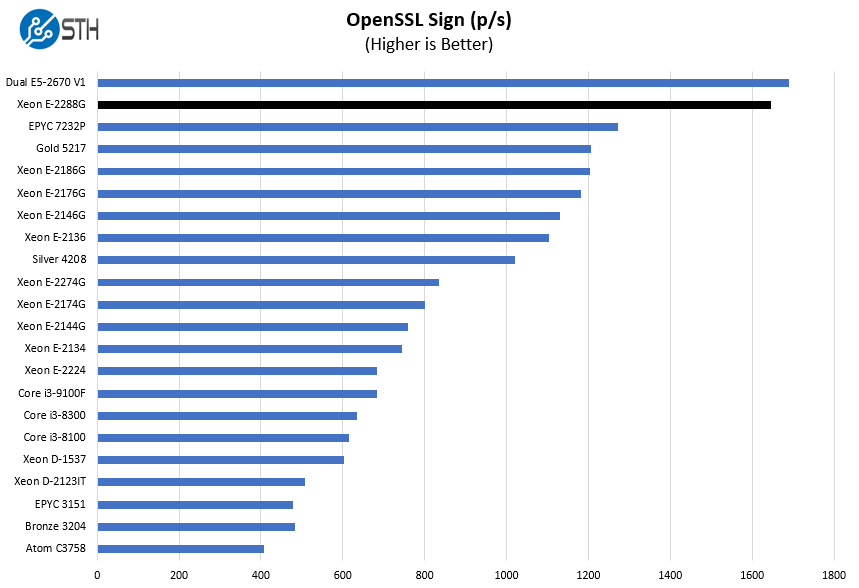
Here are the verify results:
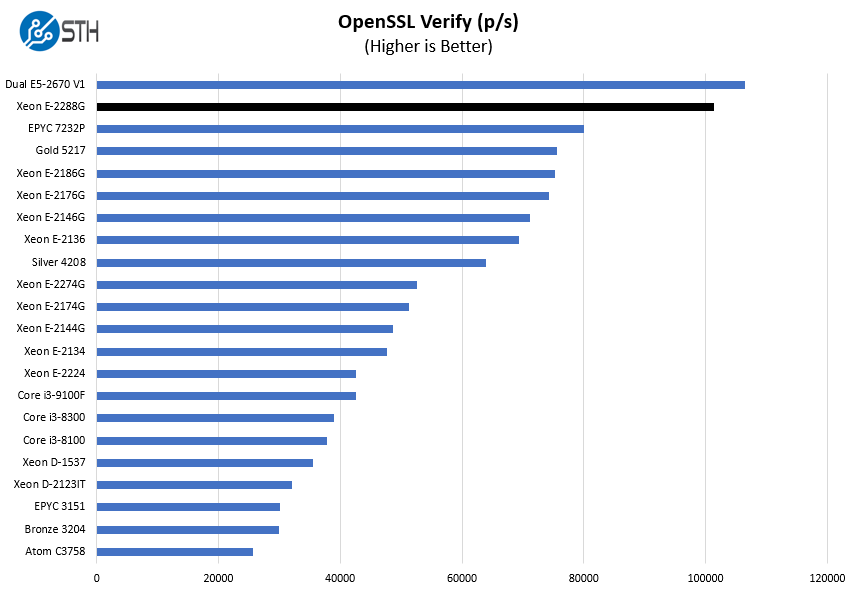
You will notice a new result in these charts that we wanted to bring in and focus on. The Intel Xeon E5-2670 we first benchmarked in 2013 and they were immensely popular with enterprises and even cloud providers. By 2016 they were being dumped on the secondary market from decommissioned servers for as low as $60 each. At this point, we are almost at a 2:1 socket consolidation ratio from the Xeon E5-2670 to the Xeon E-2288G. That is also from the full quad-channel memory sockets to the lower-end segment socket. At this point, the Xeon E-2288G provides a newer platform with low power consumption.
UnixBench Dhrystone 2 and Whetstone Benchmarks
Some of the longest-running tests at STH are the venerable UnixBench 5.1.3 Dhrystone 2 and Whetstone results. They are certainly aging, however, we constantly get requests for them, and many angry notes when we leave them out. UnixBench is widely used so we are including it in this data set. Here are the Dhrystone 2 results:
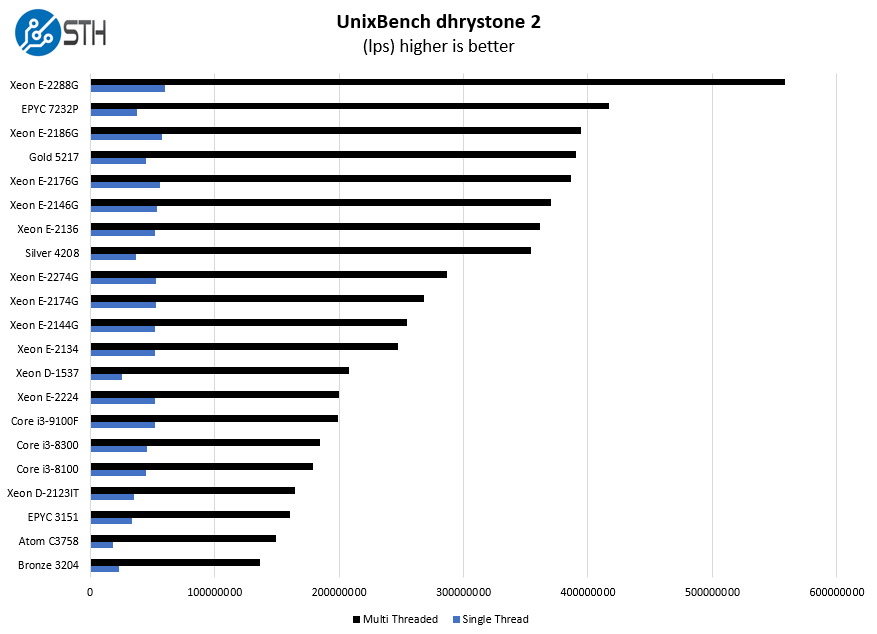
Here are the whetstone results:
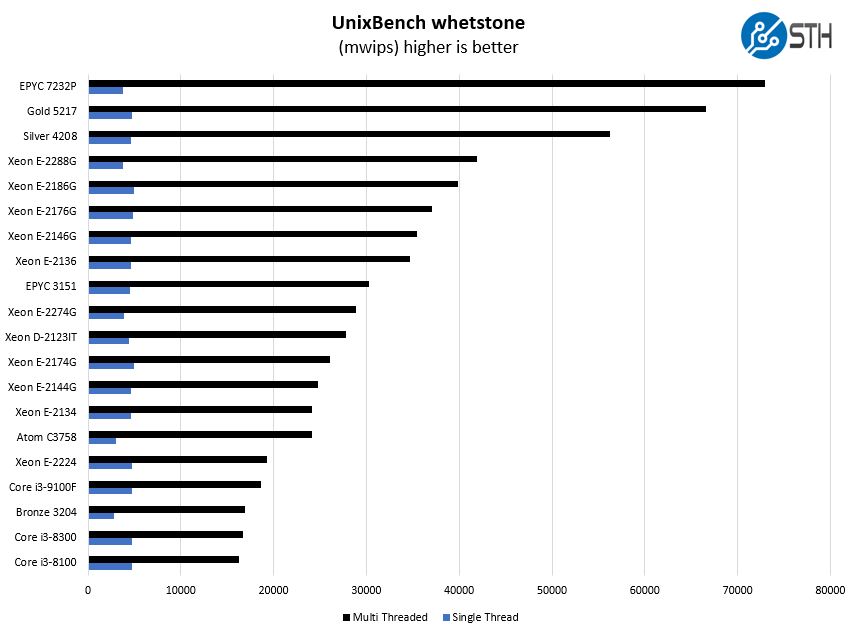
Oftentimes, the Xeon E-2200 series is used in a similar manner to the Xeon Bronze/ Silver chips and the AMD EPYC 7232P or EPYC 7262. Some companies still deploy dedicated DHCP servers or storage servers where very little compute is required. Although the Intel Xeon E-2288G provides a lot of performance, it does not provide much by way of connectivity. The higher-end Xeon platforms have more PCIe lanes and more memory capacity. They also have options to use Lewisburg PCH Options that include 10GbE and QuickAssist. Lower-end AMD EPYC chips have more PCIe lanes and memory capacity than two of the Xeon Silver/ Bronze CPUs. If your goal is to use a small number of hard drives and lower-speed networking, the Intel Xeon E series is great. If you simply do not need high-end CPU power but need a lot of expansion, then higher-end chips are better options.
GROMACS STH Small AVX2/ AVX-512 Enabled
We have a small GROMACS molecule simulation we previewed in the first AMD EPYC 7601 Linux benchmarks piece. In Linux-Bench2 we are using a “small” test for single and dual-socket capable machines. Our medium test is more appropriate for higher-end dual and quad socket machines. Our GROMACS test will use the AVX-512 and AVX2 extensions if available.
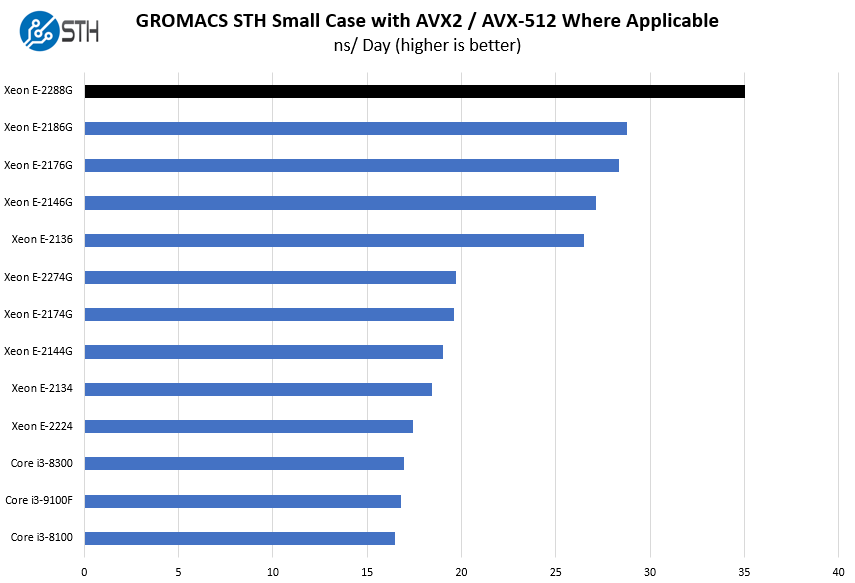
We are looking at the performance throughout the range. We found that the chips are being TDP limited. One still gets more performance than the six-core parts by a very appreciable amount.
Chess Benchmarking
Chess is an interesting use case since it has almost unlimited complexity. Over the years, we have received a number of requests to bring back chess benchmarking. We have been profiling systems and are ready to start sharing results:
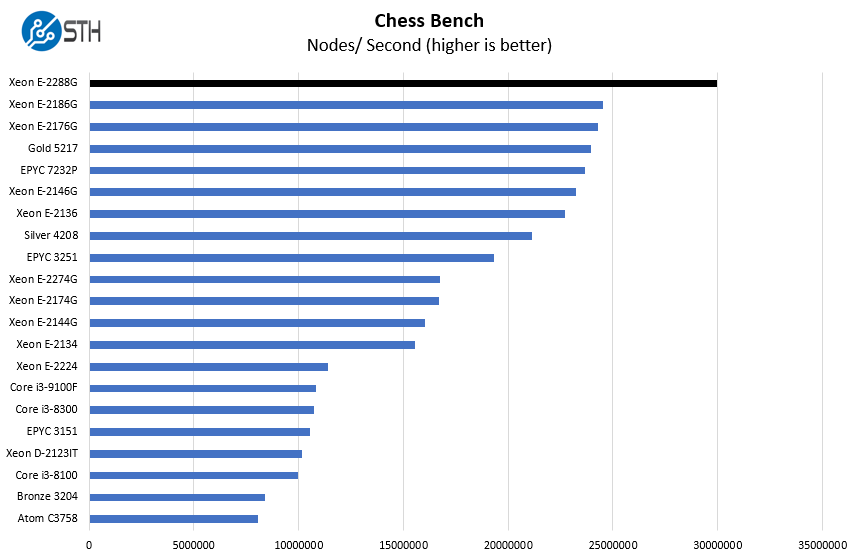
Here one can again see the Intel Xeon E-2288G top our charts. This chip is an absolute monster from a performance perspective in this segment. It also has the iGPU for transcoding and video offloading tasks that the EPYC and Xeon Scalable chips do not have.
Next, we are going to have power consumption, market positioning, and our final words.




That’s an incredible low-end chip compared to what’s out there, but it’s a Core i9 8c at heart released a year later and almost 6mo after it’s found in workstations.
So, essentially a 9900K rebranded as a Xeon and capable of using ECC RAM? Nice! Are lots of cores at lower speeds really going to help the small office with 10-20 folks running a basic, self-hosted single file and print server?
Am I right thinking this might be a great pfSense CPU if one is trying to achieve high VPN throughput (Gigabit+) due to it’s dependence on single-thread performance and this chip’s high clock speeds?
Am I blind or there is really no remark about meltdown/spectre state of fixes in the e-22xx line or in 2288g anywhere? No in this article, nor in the original e-22xx nor in the linked e-22xx. I’d really like to have some affirmation that at least meltdown is fixed in actual silicon — which it should as rumors points out. But having a word from respectable STH about the problem would be nice to have…Thanks!
It would be fantastic if STH may add something to the Petr’s comment on https://www.servethehome.com/intel-core-i3-9100f-review-for-servers/ — e.g. what exactly is fixed in R0 silicon.
Thanks, I was looking forward to reading a review of the new Xeon E eight-core models. I am currently using a four-core Xeon E in my home workstation, and thinking about upgrading.
Shame these are unobtanium. I have only just managed to get hold of a E2100 series chip after almost a year of trying…
Unobtanium would be a good description, but unobtanium can at least be found on Pandora. The E-2288G can not be found ANYWHERE. This is a sick joke from Intel. They have now announced it TWICE and are still not selling it!
Neither is it available on the open market, but the delivery time of Fujitsu Workstations with the E-2288G are disastrous as well, so they must not be getting them either.
I just received this little baby and will install it on the HP Z2 G4 Tower, I will also install the Quadro RTX5000 on this machine and install 128GB DDR4 2666 UDIMM ram
INSTALLED NEW INTEL XEON E2288G CPU!!
I will be selling this custom built machine for $10K if anyone is interested hit me up. Specs are below.
NEWLY RELEASED FEATURE – Installed is the newest 2019 Intel release CPU, the flagship 8 CORE (5GHZ single core turbo) – Xeon E-2288G.
HP Z2 G4 WORKSTATION (SYSTEM MAXIMISED) General Features include:
3 YEARS WARRANTY!!
IN THE HP BOX!!
Windows 10 PRO 64Bit
128GB DDR4 2666 ECC UDIMM RAM
Intel Xeon E-2288G (8 Core/Released 2019 – Newest Fastest Intel single CPU on the planet)
This is currently the flagship CPU for this model HP system, the new Intel Xeon E-2288G
256GB HP Z TURBO TLC M.2 (2 x slots for M.2)
1x 1TB NVMe PCie M.2 SSD
1x 2TB SSD
12TB Ultrastar Enterprise
Nvidia Quadro RTX5000)
GC DVDRW
HP Thunderbolt 3
HP Keyboard+Mouse
@Gerald and John L: A simple google search for E-2288G and clicking “shopping” yields 2 results, although both above the 550$ price mentioned here…
What about 2278G, what is the benchmark difference?
John, we have not gotten the E-2278G but you can do a rough back-of-the-envelope calculation just looking at the clock speed delta.